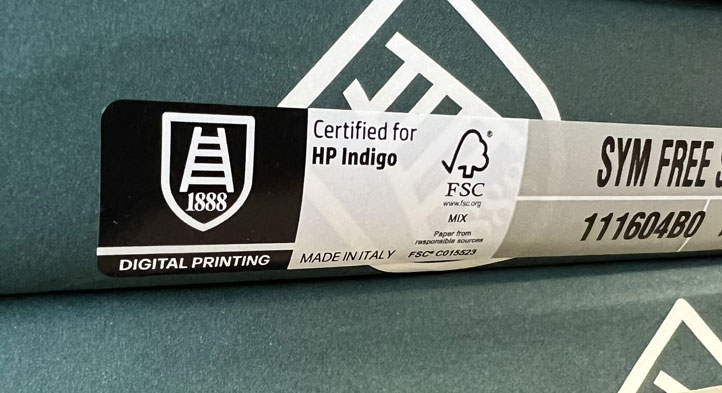
Ah, print! In a world where our lives are increasingly digitised, where eBooks and online articles are just a click away, it’s easy to overlook the quaint charm of print. But let’s not be too hasty to dismiss this old friend. In the hustle and bustle of the digital age, print stands out as a beacon of tangibility and tradition.
It’s like that cosy, familiar coffee shop in your neighbourhood that you keep returning to amidst the city’s flashy new cafes. The smell of fresh ink on paper, the feel of a book in your hands – there’s something about print that digital pixels just can’t replicate.
For those of us who adore print – be it graphic designers, marketers, or the proud printers themselves – this article is a toast to the enduring magic of print. So, let’s dive in and explore why, even in the midst of our screen-dominated lives, print continues to hold its ground, charming and surprising us in ways we often forget.
Table of Contents:
- The Tangible Charm of Print
- Print in the World of Marketing
- Sustainability and Innovations in Printing
- Embracing Eco-Friendly Practices
- Innovations in Printing Technology
- The Road Ahead: Envisioning the Future of Print
- Print as a Tool for Education and Literacy
- Conclusion
The Tangible Charm of Print
There’s something undeniably special about holding a printed piece in your hands. It’s a sensory experience. The texture of the paper. The visual feast of colours. Even the smell of a new book or magazine. In a world where so much of our media consumption happens on screens, the physical nature of print provides a welcome contrast.
Picture this: a beautifully designed magazine with glossy pages, or a hardback book with its spine cracking ever so slightly as you open it for the first time. These experiences create memories and emotions that digital media struggle to match. It’s no wonder that, despite the convenience of digital, many of us still flock to bookstores and eagerly await the arrival of our favourite print publications.
And it’s not just about nostalgia. Print has a way of capturing our attention that is different from digital. We tend to skim and scan on our devices, but with print, we’re more likely to engage deeply, to absorb and reflect. There’s a reason why printed materials are often used for important information or cherished keepsakes – they signal that what’s inside is worth paying attention to.
From personal diaries to huge billboards, print holds a unique place in our hearts and our world. It’s tactile and engaging. But above all, it’s human. In an age of brief digital content, the lasting nature of print is something to be celebrated.
In an age where digital media dominates, the tangible charm of print stands out, offering a unique and enduring experience that goes beyond mere visual consumption.
Print in the World of Marketing
A Tangible Impact
In the digital age, marketing has largely shifted online, but the power of print in the marketing mix is as significant as ever. Here’s why:
- Higher Engagement: Print materials often enjoy longer engagement times compared to digital ads. People tend to spend more time reading a brochure or a flyer than they do a social media ad.
- Trust Factor: Studies suggest that consumers trust print advertisements more than their digital counterparts. There’s a sense of legitimacy in a physical ad that digital struggles to match.
- Memorable Brand Experiences: Print allows for creative, tactile, and memorable brand experiences. From textured business cards to innovative packaging, print adds a dimension that digital can’t replicate.
 |
|
Techniques such as raised Spot UV add a different dimension to print that screen-based marketing just cannot replicate.
|
Bridging Print and Digital
In today’s marketing landscape, the fusion of print and digital is not just innovative – it’s essential. This blend offers a varied approach that leverages the tactile impact of print and the vast reach of digital. Here’s how this synergy is creating waves:
- Augmented Reality (AR) in Print: Imagine pointing your smartphone at a magazine page and watching it come to life. AR in print does exactly that, creating an immersive experience that captivates audiences.
- QR Codes: These nifty little squares have transformed print materials into interactive gateways. Scanning a QR code on a brochure or business card can lead a customer to a video, a sign-up page, or exclusive online content, creating a seamless journey from print to digital.
- Personalisation: Digital printing technologies have evolved to allow for high levels of personalisation in print. This means marketers can now merge data-driven digital strategies with personalised print materials, like customised direct mail that addresses the recipient by name and contains content tailored to their interests.
- Social Media Integration: Print campaigns increasingly include social media elements. A poster for an event might include hashtags or a Snapchat code, encouraging digital engagement and amplifying the campaign’s reach.
 |
|
QR Codes are an excellent bridge between printed and digital marketing
|
By bridging these two worlds, marketers and designers are not just reaching wider audiences; they’re creating more meaningful and engaging experiences. This symbiosis between print and digital is not just the future of marketing. It’s a vivid testament to the evolving and unyielding power of print.
Surprisingly, direct mail enjoys a high readership rate. According to recent studies, up to 90% of direct mail gets opened, compared to only 20-30% of emails.
A Canvas for Creativity
Graphic designers often find a unique and rewarding canvas in print media. Here’s why:
- Texture and Material: The choice of paper, the printing technique, and the finishes (like embossing or foil stamping) can transform a design, adding layers of depth and character.
- Colour Richness: The vibrancy and richness of colours in print are unparalleled. The way ink interacts with paper offers a visual quality that screens cannot replicate.
- Craftsmanship and Detail: Print allows for intricate details that showcase craftsmanship, from the precision of letterpress to the elegance of hand-bound books.
Sustainability and Innovations in Printing
Embracing Eco-Friendly Practices
As environmental concerns become increasingly paramount, the printing industry is stepping up with sustainable solutions. Here’s how:
- Recycled and Sustainable Materials: The use of recycled papers, FSC accredited papers, and eco-friendly inks has become more prevalent, significantly reducing the environmental footprint of print materials.
- Energy-Efficient Printing Processes: Advances in technology mean that modern printing processes use less energy and produce fewer emissions than ever before.
- Waste Reduction Strategies: From minimising ink wastage to implementing efficient paper use, the industry is constantly finding ways to reduce waste. For more information about ways in which the print and paper industry are helping our planet, visit TwoSides.info.
 |
|
All paper used at Flexpress is FSC accredited.
|
Innovations in Printing Technology
The printing world has always been a hotbed of innovation, and recent advancements are keeping this tradition alive. One of the most exciting developments is in the realm of 3D printing. This technology is not just for creating models or prototypes anymore; it’s evolving into a method for producing finished products across various industries. From customised medical implants to architectural models, 3D printing is reshaping our understanding of what printing can achieve.
Another significant advancement is in digital printing. Modern digital printing offers unprecedented quality and flexibility, making it suitable for a wide range of projects. Whether it’s a small run of personalised postcards or a perfect bound book, digital printing can handle it efficiently and with a high level of detail. This flexibility is particularly beneficial for businesses and designers who require quick turnaround times and high customisation levels.
Interactive print is yet another area where innovation is thriving. By using technologies like conductive inks, print materials are becoming interactive platforms. Imagine a poster that responds to touch or a magazine cover that lights up – these are not just concepts but realities in today’s printing world.
The Road Ahead: Envisioning the Future of Print
As we peer into the future of the printing industry, one cannot ignore the burgeoning role of Artificial Intelligence (AI). AI is set to revolutionise print in several exciting ways. From automating design processes to creating smarter, more efficient workflows, AI is already beginning to make its mark. It enables predictive maintenance for printing machinery, optimising operations and reducing downtime.
AI also holds tremendous potential in personalization. Imagine AI algorithms that analyse customer data to create highly personalised print materials, catering to individual preferences and behaviours. This level of customization, powered by AI, could redefine marketing and advertising strategies, making them more effective and customer-centric.
The focus on sustainability is likely to grow even stronger, with the industry developing more eco-friendly materials and processes. This commitment to the environment will not only reduce the ecological impact of print but also resonate with consumers who are increasingly environmentally conscious.
Moreover, the potential for customization and personalization in print is bound to expand. As digital printing technology advances, we’ll see even more creative and individualised print solutions, catering to the specific needs and preferences of users.
In essence, the road ahead for print is exciting and full of possibilities. It’s a journey that promises to keep print relevant, innovative, and indispensable in our increasingly digital world.
The road ahead for print is marked by technological advancement and sustainable practices. AI is not just a buzzword; it’s a powerful force driving the evolution of print, ensuring its relevance and dynamism in the digital age.
Print as a Tool for Education and Literacy
In the digital age, it’s easy to overlook the role of print in education and literacy, but its impact is profound and far-reaching. Here’s why print remains an invaluable educational tool:
Fostering Deep Learning
Studies have shown that reading printed material allows for deeper comprehension and retention compared to digital reading. There’s something about the physical act of turning pages that aids in memory and understanding. Print also encourages a more focused reading experience, free from the distractions of notifications and hyperlinks.
Accessibility and Inclusivity
Printed materials are vital for accessibility in education. They provide an inclusive learning medium that does not rely on access to digital devices or internet connectivity. This is crucial in bridging the digital divide and ensuring equitable access to educational resources for students from all backgrounds.
The Joy of Reading
There’s a unique joy in the experience of reading printed books, especially for children. Picture books, with their vibrant illustrations and tactile pages, play a crucial role in early literacy and language development. They also help foster a lifelong love for reading.
Supporting Diverse Learning Styles
Print caters to diverse learning styles. For visual learners, well-designed textbooks and diagrams can be more effective than digital equivalents. For kinesthetic learners, the physical interaction with print materials can aid in the learning process.
Print in Educational Spaces
The presence of printed materials in classrooms, libraries, and homes creates an environment that encourages learning and curiosity. From posters on classroom walls to stacks of books in libraries, print creates a tangible and inviting educational landscape.
Print remains a cornerstone in education, offering unique advantages that digital formats have yet to replicate fully. It’s not just about reading. It’s about creating an engaging, inclusive, and effective learning experience.
Conclusion
As we’ve journeyed through the various facets of print in our increasingly digital world, one thing becomes crystal clear: print is not just surviving; it’s thriving with a unique blend of tradition and innovation. From the tactile charm that evokes emotion to its undeniable impact in marketing, print continues to play a crucial role in our lives.
Graphic designers find a canvas for creativity in print that digital platforms struggle to replicate. The printing industry’s commitment to sustainability and the exciting innovations, especially with the integration of AI, point to a future where print remains relevant and eco-friendly. In education, the value of print in fostering deep learning and literacy is undeniable.
In essence, print holds a special place that digital media cannot usurp. It’s a medium that engages, inspires, and connects us in a deeply personal way. As we look ahead, the future of print is one of adaptation and growth, where it continues to complement the digital world while retaining its unique essence.
Print, with its rich history and evolving nature, stands as a testament to the human desire for tangible connections and experiences. In our fast-paced, screen-dominated lives, the allure of print is a grounding force, reminding us of the joy found in simplicity and the physical world.




























